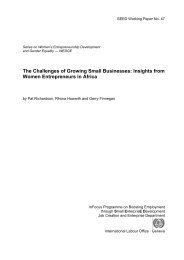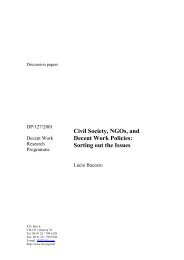manual: women workers' rights and gender equality - International ...
manual: women workers' rights and gender equality - International ...
manual: women workers' rights and gender equality - International ...
You also want an ePaper? Increase the reach of your titles
YUMPU automatically turns print PDFs into web optimized ePapers that Google loves.
Card 1: No to Suppression of Freedom, Yes to Workers to Organize (picture No. 24)<br />
Convention 87: Freedom of Association <strong>and</strong> Protection of the Right to Organize, 1948<br />
Workers <strong>and</strong> employers must have the right to establish <strong>and</strong> join organizations of their own<br />
choosing with a view to defending <strong>and</strong> furthering their respective interests.<br />
Convention 98: Right to Organize <strong>and</strong> Collective Bargaining Convention, 1949<br />
Protection of workers who are exercising the right to organize; non-interference between workers’<br />
<strong>and</strong> employers’ organization; promotion of voluntary collective bargaining.<br />
Both Conventions are ratified by the Cambodian Government.<br />
The right to organize is also protected by the Constitution. Section 36.5 states that Khmer citizens<br />
of either sex shall have the right to form <strong>and</strong> to be members of trade unions.<br />
This is very important to informal sector workers. They can fight to get more <strong>rights</strong> by organizing<br />
themselves (see the session about Right to Organize for more details).<br />
In the Labour Code 1997 chapter 11 deals with Trade Union Freedom <strong>and</strong> Worker Representation<br />
in the Enterprise. Section 1 gives provisions about the right to form a union, section 2 deals with<br />
the protection of trade unions’ freedom <strong>and</strong> section 3 is about the representation of workers in the<br />
enterprise.<br />
Card 2: No to Forced Labour, Yes to Free Labour (picture No. 25)<br />
Convention 29: Forced Labour <strong>and</strong> C105: Abolition of Forced Labour<br />
To prohibit <strong>and</strong> suppress forced or compulsory labour in all its forms.<br />
Both Conventions are ratified by the Cambodian Government.<br />
Section 5 of chapter 1 in the Labour Code 1997 is about forced labour. Article 15 states: forced or<br />
compulsory labor is absolutely forbidden in conformity with the <strong>International</strong> Labour Convention no.<br />
29 on forced or compulsory labour. Article 16 says that hiring of people for work to pay off debts is<br />
forbidden.<br />
Card 3: No to Child Labour, Yes to Education (picture No. 26)<br />
Convention 138: Minimum Age<br />
No persons under the age of 15 are allowed to work<br />
Convention 182: Worst Forms of Child Labour<br />
To eliminate the worst forms of child labour. Among the worst forms of child labour are: all forms of<br />
slavery, prostitution or pornography, work which is likely to harm the health, safety or morals of<br />
children <strong>and</strong> illicit activities like trafficking or production of drugs.<br />
Convention 182 is not yet ratified by the Cambodian Government but Convention 138 is.<br />
In the Constitution, article 48 states that the State shall protect the <strong>rights</strong> of the children as<br />
stipulated in the UN Convention on the Rights of the Child (1989), in particular, the right to life,<br />
education, protection during wartime, <strong>and</strong> from economic or sexual exploitation. Children shall be<br />
protected from acts that are injurious to their educational opportunities, health <strong>and</strong> welfare (see the<br />
session on Child Labour for more details).<br />
55

















